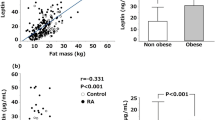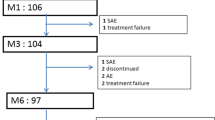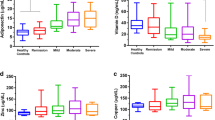Abstract
Adiponectin is divided into high-molecular-weight (HMW), medium-molecular-weight (MMW), and low-molecular-weight (LMW) forms. These forms differ not only in the number of adiponectin molecules but also in their biological activity. There are conflicting findings regarding the role of adiponectin in rheumatoid arthritis (RA). Moreover, few reports have described the relationships between serum adiponectin multimers levels and RA. Therefore, we examined the association of total adiponectin and its multimers with RA. Two study groups were examined: 180 recently diagnosed untreated RA patients with disease duration less than 1 year (RA group) and 160 age- and sex-matched control subjects (control group). RA-related factors, blood pressure, body mass index, glucose, complete lipid profile, and adiponectin multimers were measured. The levels of total adiponectin and each multimer of adiponectin were significantly lower in the RA than in the control (P < 0.01). Serum levels of total, HMW, MMW, and LMW were positively correlated with triglycerides levels and negatively correlated with the Disease Activity Score for 28 joints (DAS28). Multivariate regression analysis showed that total, HMW, and MMW adiponectin were independently associated with serum triglycerides level. LMW adiponectin was independently correlated with serum triglycerides level and DAS28. The decreased LMW adiponectin levels may be associated with disease activity of RA.
Similar content being viewed by others
Avoid common mistakes on your manuscript.
Introduction
Rheumatoid arthritis (RA) is a chronic, systemic, inflammatory disease, which affects predominantly synovial joints, causing irreversible joint destruction [1]. Adiponectin is a protein, mainly secreted by adipose tissue and abundantly present in the circulation, accounting for 0.01 % of total plasma protein. It is associated with glucose and lipid metabolism [2–5]. The potential role of adiponectin in RA has been actively investigated. Conflicting data on adiponectin’s role in RA has been reported. Serum level of adiponectin was found to be similar, lower, or higher in comparison with healthy controls or with osteoarthritis patients [6–10]. Interestingly, adiponectin exists in different higher-order complexes. In the circulation, adiponectin is predominantly present in characteristic multimeric complexes: a low-molecular-weight (LMW; trimer), a medium-molecular-weight (MMW; hexamer), and a larger high-molecular-weight (HMW; 12–36mer) adiponectin form [11]. These three forms differ not only in the number of adiponectin molecules but also in their biological activity [12–14]. MMW and LMW adiponectin have been suggested to be less important than HMW adiponectin in regard to the lipid metabolism [15–17]. Consequently, while HMW adiponectin has been studied by many researchers, studies of MMW and LMW adiponectin have not been sufficient. It is possible that MMW and/or LMW adiponectin are related to chronic inflammation [18, 19]. The correlation of RA with serum levels of MMW and/or LMW adiponectin has never been previously investigated.
Therefore, the aims of this study are (1) to determine whether there is an alteration of adiponectin and its multimer levels in patients with RA, and (2) to determine the association of adiponectin multimers concentrations with RA-related biochemical factors.
Patients and methods
Patients
Some studies have showed that serum adiponectin level is significantly higher in females than in males [20]. Therefore, to investigate the correlation between serum adiponectin level and disease activity in established RA, 180 Chinese female patients with RA diagnosed according to 1987 revised criteria of the American College of Rheumatology were enrolled in this study [21]. All the patients had RA disease duration <1 year and were steroid- and disease-modifying anti-rheumatic drugs (DMARDs)-naive. The 160 age- and sex-matched healthy volunteers were recruited as controls. The individuals of control group had no history of rheumatic disease. Subjects with history of acute infection; other connective tissue diseases; malignancy; smoking; body mass index (BMI) >30 kg/m2; diabetes; hypertension; hyperuricemia; concomitant renal, hepatic, cardiac, or endocrine diseases; or taking medications affecting lipid metabolism or taking thiazolidinediones were excluded from the study.
Ethics and consent
The study has been approved by the Ethics Committee of China-Japan Union Hospital and has been performed in accordance with the 1964 Declaration of Helsinki and its later amendments. All participants gave their informed consent prior to their inclusion in the study.
Measurements
Systolic blood pressure (SBP), diastolic blood pressure (DBP), height, weight, fasting serum glucose, lipid profile, C-reactive protein (CRP), erythrocyte sedimentation rate (ESR), anti-cyclic citrullinated peptide (anti-CCP), rheumatoid factor IgM (RF-IgM), RF-IgG, and RF-IgA were measured at around 9:00 AM after an overnight fast. Disease activity of RA was determined using Disease Activity Score for 28 joints (DAS28) calculated with the ESR, visual analogue score (VAS), and the number of tender and swollen joints, from a total of 28 joints assessed [22, 23]. Serum samples were obtained and stored at −80 °C. The concentrations of total and multimeric adiponectin in the sera were measured by human adiponectin multimeric enzyme-linked immunosorbent assay (ELISA) kit (Alpco, Salem, NH, USA) per manufacturer’s instructions.
Statistical analysis
Data with normal distribution were expressed as mean ± SD, while variables non-normally distributed were reported as median (interquartile range, IQR). Differences in continuous variables between groups were evaluated by unpaired Student’s test or Mann–Whitney test. Univariate analysis was done to explore relationships between adiponectin multimers and other variables by Pearson correlation test for normally distributed data and Spearman rank correlation test for nonparametric data. While stepwise multiple regression analysis was used to detect independent predictive variables. When that analysis was conducted, we converted the HMW, MMW and LMW adiponectin concentrations into common logarithms because none concentration had a normal distribution. All statistical analysis was performed using the SPSS (SPSS ver 17.0 for Window, Chicago, IL, USA) software package. Differences were considered statistically at P < 0.05.
Results
Demographic and disease-related variables
Table 1 presents the basic characteristics of the study groups. The characteristics had no difference between RA patients and controls.
The mean disease duration was 6 (4.00–11.00) months. One hundred twenty-two (67.78 %) patients were RF-IgG positive, 101(56.11 %) were RF-IgA positive, 131 (72.78 %) were RF-IgM positive, and 129 (71.67 %) were anti-CCP positive. The mean DAS28 was 6.11 ± 1.37, indicating a high degree of active disease. Of the RA group, 59.44 % were receiving nonsteroidal anti-inflammatory drugs (NSAIDs).
Serum levels of adiponectin multimers
Because all included study subjects were women, no population sexual dimorphism of adiponectin distribution could be evaluated. The levels of total adiponectin and each multimer of adiponectin were lower in the RA than in the control. Significant differences were observed in the levels of total, HMW, MMW, and LMW adiponectin. We also compared the differences of the total adiponectin and multiers levels between the RA patients with (NSAIDs+) or without NSAIDs treatment (NSAIDs−). The levels of total adiponectin and each multimer of adiponectin were similar in these two groups (Table 2).
The serum levels of adiponectin multimers and total adiponectin in patients with or without RF-IgG, RF-IgA, RF-IgM, or anti-CCP
The serum levels of adiponectin multimers and total adiponectin were compared in regard to the RF-IgG, RF-IgA, RF-IgM, or anti-CCP positivity using Mann–Whitney test, and the findings are shown in Table 3. There was no significant difference between the groups in regard to the RF-IgG, RF-IgA, RF-IgM, or anti-CCP positivity (Table 3).
Correlation between adiponectin multimers and patient characteristics
We compared the correlation of total adiponectin and its multimers with various patient characteristics (age, BMI, SBP, DBP, cholesterol, triglycerides, high-density lipoprotein (HDL), low-density lipoprotein (LDL), glucose, duration of RA, RF-IgG, RF-IgA, RF-IgM, anti-CCP, ESR, CRP, and DAS28) (Table 4). We demonstrated that (1) serum levels of total, HMW, MMW, and LMW adiponectin were positively correlated with triglycerides levels (r = 0.275, P = 0.031; r = 0.258, P = 0.039; r = 0.261, P = 0.031; r = 0.247, P = 0.027, respectively); (2) serum levels of total, HMW, MMW, and LMW correlated negatively with DAS28 (r = −0.357, P = 0.013; r = −0.339, P = 0.029; r = −0.361, P = 0.018; r = −0.408, P < 0.001, respectively); (3) there was no significant correlation between total adiponectin and its multimers with any other characteristic of RA patients.
In multiple linear regression analysis, total, HMW, and MMW adiponectin were independently associated with serum triglycerides level. However, LMW adiponectin was independently correlated with serum triglycerides level and DAS28 (Table 5).
Discussion
In the present study, we measured serum levels of total adiponectin and its all three multimers in early diagnosed RA patients. In previous studies, there are limited data concerning the role of MMW and/or LMW adiponectin in RA; most studies are mainly based on total and/or HMW adiponectin.
In this study, the average age, BMI, blood pressure, and levels of cholesterol, triglycerides, HDL, LDL, and glucose were closely similar to those of the controls. However, obvious difference was observed in the level of total adiponectin. This finding supports the concept of Sahar et al., who found recently diagnosed RA patients had lower adiponectin than control group [8]. However, our result is apparently in contrast with other studies showing adiponectin plasma levels of RA patients did not differ significantly or were markedly increased in comparison with healthy controls. Almost all patients enrolled in these studies received anti-TNF, methotrexate, or glucocorticoid treatments [24–27]. Recent reports in literature demonstrate that treatments with these drugs were associated with an increase in adiponectin levels [28, 29]. Therefore, we enrolled patients with very early steroid- and DMARD-naive active RA. It might be the major reason that caused the difference between the results of these studies and ours. Moreover, other factors might also result in the difference, such as difference in disease duration, sample size, and race of the studied subjects.
It is worth mentioning that circulating multimeric forms influence biological activity of adiponectin [10, 11]. Thus, total adiponectin levels may not adequately reflect the effects of this adipokine on RA. The present study showed that serum levels of total, HMW, MMW, and LMW were positively correlated with triglycerides levels, and negatively with DAS28. However, the association between total adiponectin levels and DAS28 was attenuated after adjustment for triglycerides levels in the case of HMW and MMW adiponectin, but not LMW adiponectin. This finding may indicate that the association between total, HMW, MMW adiponectin and DAS28 were secondary to triglycerides levels. Our results also indicate that LMW adiponectin is associated with the DAS28 more strongly than total, HMW, and MMW adiponectin. Laurberg et al. and Komai et al. demonstrated that serum adiponectin levels negatively correlated with disease activity of RA [29, 30]. However, there are several studies showing that adiponectin levels had no correlation with inflammatory markers (CRP or DAS28) [31, 32]. In all of these studies, the researchers measured only total adiponectin and did not investigate the association between DAS28 and the multimers of adiponectin. It might cause that discrepancy. As far as we know, the relationship between LMW adiponectin and disease activity of RA has not been investigated. It is known that LMW adiponectin is anti-inflammatory cytokine, suppressing lipopolysaccharide-mediated release of IL-6, and stimulating the secretion of anti-inflammatory cytokine IL-10, but other functions of LMW adiponectin have not been determined [10]. Further investigation exploring the mechanism of these results is needed.
Several limitations of this study must be taken into consideration when interpreting the data. First, participants in this study were Chinese individuals from one district and females only. The generalizability may be a problem. Second, the cross-sectional design of our study resulted in that prognostic significance of adiponectin multimers could not be evaluated. The major strengths of this study were the well-characterized population, matched case controls, and the fact that we measured the levels of each adiponectin multimers.
Conclusion
The results of this study suggest RA patients have a different adiponectin multimer pattern and the decreased LMW adiponectin levels may be associated with disease activity of RA. However, additional work is necessary in order to understand the significance of these findings, particularly how different adiponectin multimers contribute to RA.
References
van Nies JA, Krabben A, Schoones JW, Huizinga TW, Kloppenburg M, van der Helm-van Mil AH (2014) What is the evidence for the presence of a therapeutic window of opportunity in rheumatoid arthritis? A systematic literature review. Ann Rheum Dis 73:861–70
Klein-Wieringa IR, Andersen SN, Herb-van Toorn L, Kwekkeboom JC, van der Helm-van Mil AH, Meulenbelt I et al (2014) Are baseline high molecular weight adiponectin levels associated with radiographic progression in rheumatoid arthritis and osteoarthritis? J Rheumatol 41:853–7
Lee S, Kwak HB (2014) Role of adiponectin in metabolic and cardiovascular disease. J Exerc Rehabil 10:54–59
Lim S, Quon MJ, Koh KK (2014) Modulation of adiponectin as a potential therapeutic strategy. Atherosclerosis 233:721–8
Mather KJ, Goldberg RB (2014) Clinical use of adiponectin as a marker of metabolic dysregulation. Best Pract Res Clin Endocrinol Metab 28:107–17
Kim KS, Choi HM, Ji HI, Song R, Yang HI, Lee SK et al (2014) Serum adipokine levels in rheumatoid arthritis patients and their contributions to the resistance to treatment. Mol Med Rep 9:255–60
Dessein PH, Norton GR, Badenhorst M, Woodiwiss AJ, Solomon A (2013) Rheumatoid arthritis impacts on the independent relationships between circulating adiponectin concentrations and cardiovascular metabolic risk. Mediators Inflamm. doi:10.1155/2013/461849
El-Hini SH, Mohamed FI, Hassan AA, Ali F, Mahmoud A, Ibraheem HM (2013) Visfatin and adiponectin as novel markers for evaluation of metabolic disturbance in recently diagnosed rheumatoid arthritis patients. Rheumatol Int 33:2283–9
Barbosa Vde S, Rêgo J, Antônio da Silva N (2012) Possible role of adipokines in systemic lupus erythematosus and rheumatoid arthritis. Rev Bras Reumatol 52:278–87
Krysiak R, Handzlik-Orlik G, Okopien B (2012) The role of adipokines in connective tissue diseases. Eur J Nutr 51:513–28
Bik W, Baranowska-Bik A, Wolinska-Witort E, Kalisz M, Broczek K, Mossakowska M et al (2013) Assessment of adiponectin and its isoforms in Polish centenarians. Exp Gerontol 48:401–7
Foucan L, Maimaitiming S, Larifla L, Hedreville S, Deloumeaux J, Joannes MO et al (2014) Adiponectin gene variants, adiponectin isoforms and cardiometabolic risk in type 2 diabetic patients. J Diabetes Investig 5:192–8
Crispim F, Vendramini MF, Japanese-Brazilian Diabetes Study Group, Moisés RS (2013) Adiponectin complexes composition in Japanese-Brazilians regarding their glucose tolerance status. Diabetol Metab Syndr 5:20
Baranowska B, Kochanowski J, Grudniak M, Baranowska-Bik A, Wolinska-Witort E, Martynska L et al (2011) Decreased total serum adiponectin and its isoforms in women with acute ischemic stroke. Neuro Endocrinol Lett 32:711–5
Aso Y, Yamamoto R, Wakabayashi S, Uchida T, Takayanagi K, Takebayashi K et al (2006) Comparison of serum high-molecular-weight (HMW) adiponectin with total adiponectin concentrations in type 2 diabetic patients with coronary artery disease using a novel enzyme-linked immunosorbent assay to detect HMW adiponectin. Diabetes 55:1954–60
Saisho Y, Hirose H, Roberts R, Abe T, Kawabe H, Itoh H (2013) C-reactive protein, high-molecular-weight adiponectin and development of metabolic syndrome in the Japanese general population: a longitudinal cohort study. PLoS One 8:e73430
Eglit T, Ringmets I, Lember M (2013) Obesity, high-molecular-weight (HMW) adiponectin, and metabolic risk factors: prevalence and gender-specific associations in Estonia. PLoS One 8:e73273
Matsumoto Y, Toyomasu K, Uchimura N, Ishitake T (2013) Low-molecular-weight adiponectin is more closely associated with episodes of asthma than high-molecular-weight adiponectin. Endocr J 60:119–25
Negi SI, Jeong EM, Shukrullah I, Raicu M, Dudley SC Jr (2012) Association of low plasma adiponectin with early diastolic dysfunction. Congest Heart Fail 18:187–91
Toussirot É, Binda D, Gueugnon C, Dumoulin G (2012) Adiponectin in autoimmune diseases. Curr Med Chem 19:5474–80
Arnett FC, Edworthy SM, Bloch DA, McShane DJ, Fries JF, Cooper NS et al (1988) The American Rheumatism Association 1987 revised criteria for the classification of rheumatoid arthritis. Arthritis Rheum 31:315–24
van Gestel AM, Haagsma CJ, van Riel PL (1998) Validation of rheumatoid arthritis improvement criteria that include simplified joint counts. Arthritis Rheum 41:1845–50
Prevoo ML, Hof MA v 't, Kuper HH, van Leeuwen MA, van de Putte LB, van Riel PL (1995) Modified disease activity scores that include twenty-eight-joint counts. Development and validation in a prospective longitudinal study of patients with rheumatoid arthritis. Arthritis Rheum 38:44–8
Otero M, Lago R, Gomez R, Lago F, Dieguez C, Gómez-Reino JJ et al (2006) Changes in plasma levels of fat-derived hormones adiponectin, leptin, resistin and visfatin in patients with rheumatoid arthritis. Ann Rheum Dis 65:1198–201
Stefan N, Häring HU, Stumvoll M (2004) Regulation of synovial adipocytokines. JAMA 291:694–5
Rho YH, Solus J, Sokka T, Oeser A, Chung CP, Gebretsadik T et al (2009) Adipocytokines are associated with radiographic joint damage in rheumatoid arthritis. Arthritis Rheum 60:1906–14
Nagashima T, Okubo-Fornbacher H, Aoki Y, Kamata Y, Kimura H, Kamimura T et al (2008) Increase in plasma levels of adiponectin after administration of anti-tumor necrosis factor agents in patients with rheumatoid arthritis. J Rheumatol 35:936–8
Yoshino T, Kusunoki N, Tanaka N, Kaneko K, Kusunoki Y, Endo H et al (2011) Elevated serum levels of resistin, leptin, and adiponectin are associated with C-reactive protein and also other clinical conditions in rheumatoid arthritis. Intern Med 50:269–75
Laurberg TB, Frystyk J, Ellingsen T, Hansen IT, Jørgensen A, Tarp U et al (2009) Plasma adiponectin in patients with active, early, and chronic rheumatoid arthritis who are steroid- and disease-modifying antirheumatic drug-naive compared with patients with osteoarthritis and controls. J Rheumatol 36:1885–91
Komai N, Morita Y, Sakuta T, Kuwabara A, Kashihara N (2007) Anti-tumor necrosis factor therapy increases serum adiponectin levels with the improvement of endothelial dysfunction in patients with rheumatoid arthritis. Mod Rheumatol 17:385–90
Ebina K, Fukuhara A, Ando W, Hirao M, Koga T, Oshima K et al (2009) Serum adiponectin concentrations correlate with severity of rheumatoid arthritis evaluated by extent of joint destruction. Clin Rheumatol 28:445–51
Härle P, Sarzi-Puttini P, Cutolo M, Straub RH (2006) No change of serum levels of leptin and adiponectin during anti-tumour necrosis factor antibody treatment with adalimumab in patients with rheumatoid arthritis. Ann Rheum Dis 65:970–1
Acknowledgments
The authors acknowledge all members for their participation in this research.
Disclosures
None.
Author information
Authors and Affiliations
Corresponding author
Additional information
Ping Li and Li Yang contributed equally to this work.
Rights and permissions
About this article
Cite this article
Li, P., Yang, L., Ma, Cl. et al. Low-molecular-weight adiponectin is more closely associated with disease activity of rheumatoid arthritis than other adiponectin multimeric forms. Clin Rheumatol 34, 1025–1030 (2015). https://doi.org/10.1007/s10067-015-2899-9
Received:
Revised:
Accepted:
Published:
Issue Date:
DOI: https://doi.org/10.1007/s10067-015-2899-9




